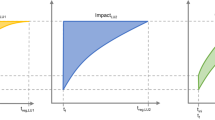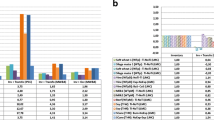Abstract
Purpose
The inclusion of land-use activities in life cycle assessment (LCA) has been subject to much debate in the LCA community. Despite the recent methodological developments in this area, the impacts of land occupation and transformation on its long-term ability to produce biomass (referred to here as biotic production potential [BPP]) — an important endpoint for the Area of Protection (AoP) Natural Resources — have been largely excluded from LCAs partly due to the lack of life cycle impact assessment methods.
Materials and methods
Several possible methods/indicators for BPP associated with biomass, carbon balance, soil erosion, salinisation, energy, soil biota and soil organic matter (SOM) were evaluated. The latter indicator was considered the most appropriate for LCA, and characterisation factors for eight land use types at the climate region level were developed.
Results and discussion
Most of the indicators assessed address land-use impacts satisfactorily for land uses that include biotic production of some kind (agriculture or silviculture). However, some fail to address potentially important land use impacts from other life cycle stages, such as those arising from transport. It is shown that the change in soil organic carbon (SOC) can be used as an indicator for impacts on BPP, because SOC relates to a range of soil properties responsible for soil resilience and fertility.
Conclusions
The characterisation factors developed suggest that the proposed approach to characterize land use impacts on BBP, despite its limitations, is both possible and robust. The availability of land-use-specific and biogeographically differentiated data on SOC makes BPP impact assessments operational. The characterisation factors provided allow for the assessment of land-use impacts on BPP, regardless of where they occur thus enabling more complete LCAs of products and services. Existing databases on every country’s terrestrial carbon stocks and land use enable the operability of this method. Furthermore, BPP impacts will be better assessed by this approach as increasingly spatially specific data are available for all geographical regions of the world at a large scale. The characterisation factors developed are applied to the case studies (Part D of this special issue), which show the practical issues related to their implementation.

Similar content being viewed by others
Notes
While midpoint modelling refers to the modelling of impacts (e.g., Climate Change) at a middle point in the cause–effect chain or environmental mechanism, endpoint modelling refers to that at the end of the cause–effect chain (i.e., damage to Human Health, Ecosystems or Natural Resources).
BPP is also referred to the conditions responsible for biological/biomass/ecosystem productivity. It is a life support function that is included in the Ecosystem Services Framework as a provisioning ecosystem service, and includes food, fibre, fuel, genetic resources, biochemicals, natural medicines and pharmaceuticals, ornamental resources and fresh water (Millennium Ecosystem Assessment 2005).
Soil organic matter (SOM) is best measured as soil organic carbon (SOC), according to Reeves (1997). SOM content is measured as density of SOC, and SOC is usually considered to be 58% of SOM, giving a conversion factor of 1.72:1 (SOM/SOC) (Brady and Weil 1999). SOC is chosen in this paper as indicator for BPP.
The only difference between the equation for calculation CFs for transformation from that for occupation is that the latter is not expressed per m2 and year and therefore excludes the denominator in Eq. 1.
References
Baan Ld, Alkemade R, Koellner T (2012) Land use impacts on biodiversity in LCA: a global approach. Int J Life Cycle Assess (this issue)
Baitz M, Kreißig J, Schoch C (1999) Method to integrate land use in life cycle assessment. IKP. Universitat Stuttgart, Stuttgart, Germany
Bare JC, Gloria TP (2008) Environmental impact assessment taxonomy providing comprehensive coverage of midpoints, endpoints, damages, and areas of protection. J Clean Prod 16(10):1021
Brady NC, Weil RR (1999) The nature and property of soils, 12th edn. Prentice-Hall, Upper Saddle River
Brandão M (2011) Food, feed, fuel, timber or carbon sink? Towards sustainable land use — a consequential life-cycle approach. University of Surrey, Guildford
Brandão M, Clift R, Milà i Canals L, Basson L (2010) A life-cycle approach to characterising environmental and economic impacts of multifunctional land-use systems: an integrated assessment in the UK. Sustainability 2(12):3747–3776
Brandão M, Milà i Canals L, Clift R (2011) Soil organic carbon changes in the cultivation of energy crops: implications for GHG balances and soil quality for use in LCA. Biomass Bioenerg 35(6):2323–2336
BSI (2011) PAS2050: specification for the assessment of the life cycle greenhouse gas emissions of goods and services. British Standards Institution
Ceschia E, Béziat P, Dejoux JF, Aubinet M, Bernhofer C, Bodson B, Buchmann N, Carrara A, Cellier P, Di Tommasi P, Elbers JA, Eugster W, Grunwald T, Jacobs CMJ, Jans WWP, Jones M, Kutsch W, Lanigan G, Magliulo E, Marloie O, Moors EJ, Moureaux C, Olioso A, Osborne B, Sanz MJ, Saunders M, Smith P, Soegaard H, Wattenbach M (2010) Management effects on net ecosystem carbon and GHG budgets at European crop sites. Agric Ecosyst Environ 139(3):363–383
Chapman PM (2008) Ecosystem services — assessment endpoints for scientific investigations. Mar Pollut Bull 56(7):1237–1238
Christensen B, Johnston AE (1997) Soil organic matter and soil quality—lessons learned from long-term experiments at Askov and Rothamsted. In: Gregorich EG, Carter MR (eds) Soil quality for crop production and ecosystem health. Elsevier, Amsterdam, pp 399–430
Cowell S (1998) Environmental life cycle assessment of agricultural systems: integration into decision-making. University of Surrey, Guildford
Cowell SJ, Clift R (2000) A methodology for assessing soil quantity and quality in life cycle assessment. J Clean Prod 8(4):321–331
EU (2010) Commission Decision of 10 June 2010 on guidelines for the calculation of land carbon stocks for the purpose of Annex V to Directive 2009/28/EC
European Commission (2010) Recommendations based on existing environmental impact assessment models and factors for Life Cycle Assessment in a European context (draft). International Reference Life Cycle Data System (ILCD) handbook. Joint Research Centre, Institute for Environment and Sustainability, Ispra, Italy
Feitz AJ, Lundie S (2002) Soil Salinisation: a local life cycle assessment impact category. Int J Life Cycle Assess 7(4):244–249
Flynn HC, Milà i Canals L, Keller E, King H, Sim S, Hastings A, Wang S, Smith P (2011) Quantifying global greenhouse gas emissions from land use change for crop production. Glob Change Biol. doi:10.1111/j.1365-2486.2011.02618.x
IPCC (2003) Good practice guidance for land use, land-use change and forestry. Institute for Global Environmental Strategies (IGES) for the Intergovernmental Panel on Climate Change. Kanagawa, Japan
IPCC (2006) 2006 IPCC Guidelines for National Greenhouse Gas Inventories. Institute for Global Environmental Strategies (IGES) for the Intergovernmental Panel on Climate Change. Kanagawa, Japan
Kennedy A, Smith K (1995) Soil microbial diversity and the sustainability of agricultural soils. Plant Soil 170(1):75–86
Koellner T, Scholz R (2007) Assessment of land use impacts on the natural environment. Part 1: an analytical framework for pure land occupation and land use change. Int J Life Cycle Assess 12(1):16–23
Koellner T, Scholz R (2008) Assessment of land use impacts on the natural environment. Part 2: generic characterization factors for local species diversity in Central Europe. Int J Life Cycle Assess 13(1):32–48
Koellner T, de Baan L, Beck T, Brandão M, Civit B, Goedkoop M, Margni M, Milà i Canals L, Müller-Wenk R, Weidema B, Wittstock B (2012a) Principles for life cycle inventories of land use on a global scale. Int J Life Cycle Assess (this issue)
Koellner T, de Baan L, Beck T, Brandão M, Civit B, Margni M, Milà i Canals L, Saad R, Maia de Souza D, Müller-Wenk R (2012b) UNEP-SETAC Guideline on Global Land Use Impact Assessment on Biodiversity and Ecosystem Services in LCA. Int J Life Cycle Assess (this issue)
Lindeijer E (2000) Review of land use impact methodologies. J Clean Prod 8(4):273–281
Lindeijer W, van Kempen M, Fraanje P, van Dobben H, Nabuurs G-J, Schouwenberg E, Prins D, Dankers D, Leopold M (1998) Biodiversity and life support indicators for land use impacts in LCA. IVAM and IBN/DLO
Mattsson B, Cederberg C, Ljung M (1998) Principles for environmental assessment of land use in agriculture. SIK Rapport (642). SIK, The Swedish Institute for Food and Biotechnology, Goteborg
Michelsen O (2008) Assessment of land use impact on biodiversity. Int J Life Cycle Assess 13(1):22–31
Milà i Canals L (2003) Contributions to LCA methodology for agricultural systems. Site-dependency and soil degradation impact assessment. Thesis, Universitat Autònoma de Barcelona, Barcelona
Milà i Canals L, Bauer C, Depestele J, Dubreuil A, Freiermuth KR, Gaillard G, Michelsen O, Müller-Wenk R, Rydgren B (2007a) Key elements in a framework for land use impact assessment in LCA. Int J Life Cycle Assess 12(1):5–15
Milà i Canals L, Muñoz I, McLaren S, Brandão M (2007b) LCA methodology and modelling considerations for vegetable production and consumption. CES Working Papers 02/07 Guildford
Milà i Canals L, Romanya J, Cowell S (2007b) Method for assessing impacts on life support functions (LSF) related to the use of 'fertile land' in life cycle assessment (LCA). J Clean Prod 15(15):1426
Milà i Canals L, Muñoz I, Hospido A, Plassmann K, McLaren S, Edwards-Jones G, Hounsome B (2008) Life Cycle Assessment (LCA) of domestic vs. imported vegetables. Case studies on broccoli, salad crops and green beans. CES Working Papers 01/08. Centre for Environmental Strategy, University of Surrey
Milà i Canals L, Rigarlsford G, Sim S (2012) Land use impact assessment of margarine. Int J Life Cycle Assess (this issue)
Millennium Ecosystem Assessment (2005) Ecosystems and human well-being: synthesis. Island Press, Washington
Müller-Wenk R, Brandão M (2010) Climatic impact of land use in LCA–carbon transfers between vegetation/soil and air. Int J life Cycle Assess 15(2):172–182. http://www.springerlink.com/content/02628184t2q98051/fulltext.pdf
Peixoto RS, Coutinho HLC, Madari B, Machado PLOA, Rumjanek NG, Van Elsas JD, Seldin L, Rosado AS (2006) Soil aggregation and bacterial community structure as affected by tillage and cover cropping in the Brazilian Cerrados. Soil Till Res 90(1–2):16
Pfister S, Curran M, Koehler A, Hellweg S (2010) Trade-offs between land and water use: regionalized impacts of energy crops. In: Proceedings of the 7th International Conference on LCA in the Agri-Food Sector; http://www.lcafood2010.uniba.it/conference-proceedings/02-Parallel_Sess1a.pdf
Reeves DW (1997) The role of soil organic matter in maintaining soil quality in continuous cropping systems. Soil Till Res 43(1–2):131
Saad R, Koellner T, Margni M (2012) Land use impacts on freshwater regulation, erosion regulation and water purification: a spatial approach for a global scale level. Int J Life Cycle Assess (this issue)
Schmidt J (2008) Development of LCIA characterisation factors for land use impacts on biodiversity. J Clean Prod 16(18):1929
Stewart M, Weidema BP (2005) A consistent framework for assessing the impacts from resource use — a focus on resource functionality. Int J Life Cycle Assess 10(4):240–247
Van-Camp L, Bujarrabal B, Gentile A-R, Jones RJA, Montanarella L, Olazabal C, Selvaradjou SK (2004) Reports of the Technical Working Groups Established under the Thematic Strategy for Soil Protection. EUR 21319 EN/1. Luxembourg, Office for Official Publications of the European Communities
Wagendorp T, Gulinck H, Coppin P, Muys B (2006) Land use impact evaluation in life cycle assessment based on ecosystem thermodynamics. Energy 31(1):112–125
WBGU (1998) The accounting of biological sinks and sources under the Kyoto Protocol — a step forwards or backwards for global environmental protection?
Weidema BP, Lindeijer E (2001) Physical impacts of land use in product life cycle assessment. Final report of the EURENVIRONLCAGAPS sub-project on land use. Technical University of Denmark, Lyngby, Denmark
Acknowledgements
We acknowledge the GIS expertise made available by Roland Hiederer and Fabien Ramos (EC-JRC). Substantive comments from two anonymous reviewers have helped improving the clarity and relevance of this paper and are kindly appreciated.
Author information
Authors and Affiliations
Corresponding author
Additional information
Responsible editor: Thomas Koellner
Electronic supplementary material
Below is the link to the electronic supplementary material.
ESM 1
Electronic supplementary material (XLSX 18 kb)
Rights and permissions
About this article
Cite this article
Brandão, M., i Canals, L.M. Global characterisation factors to assess land use impacts on biotic production. Int J Life Cycle Assess 18, 1243–1252 (2013). https://doi.org/10.1007/s11367-012-0381-3
Received:
Accepted:
Published:
Issue Date:
DOI: https://doi.org/10.1007/s11367-012-0381-3




